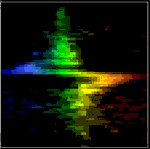"The most beautiful thing we can experience is the
mysterious; It is the source of all true art and science." -- Albert Einstein
Scientific Images & Animations
Click on each image to see it full-sized.
|
|
STEREO
Graphics Gallery Animations- NEW!
STEREO (Solar TErrestrial RElations Observatory) is the
third mission in NASA's Solar Terrestrial Probes program (STP). This two-year
mission will provide a unique and revolutionary view of the Sun-Earth
System. The two nearly identical observatories - one ahead of Earth in
its orbit, the other trailing behind – will trace the flow of energy
and matter from the Sun to Earth as well as reveal the 3D structure of
coronal mass ejections and help us understand why they happen.
Animation: STEREO spacecraft and coronal mass ejection.
Credit: NASA / Walt Feimer.
|
|
|
|
The Sun is a major influence on the Earth's weather and
climate. The focus of NASA's Sun-Solar System Connection is to understand
this relationship from the perspective of the entire system. This gallery
features videos and animations of the sun, including solar flares, coronal
mass ejections, and the solar cycle.
For more videos and animations, visit Science
Highlights from NASA's Sun-Earth Connection
|
|
|
Simulation
of Solar Convection
This simulation of turbulent convection mirrors
activity at the Sun's surface.
|
|
|
The
Sun as Art
The Sun as Art, a 21-page
image set assembled by SOHO Media Specialist Steele Hill, presents a new
way of looking at the Sun. Steele's goal was to highlight the artistic
range of colors and shapes and beauty that can be derived from a little
manipulation of the already-glorious SOHO images. In some cases an image
has only been cropped; in some, only color tables were altered; in the
most inventive, pieces have been cut and moved around. "At times whimsical
and other times instructive, the presentation tries to suggest the variety
and wonder of the Sun that SOHO has brought to us."
|
|
|
SOHO's
Halo Orbit
These images are visualizations of the information needed
to compute the orbit for the SOHO
spacecraft. SOHO needed a convenient location, orbiting around the Sun,
between the Earth and Sun, and where the gravitation of the Sun and the
Earth balance. Computing exactly that site ("the 3-body problem") and
maintaining the spacecraft there, are difficult issues. These visualizations
were created to help the scientists and engineers visualize the information
which they needed to compute the (L1) orbit point.
Images courtesy of Chris Sinclair, University
of Arizona, and Molly Megraw, previously University of Washington.
|
|
|
L-NU
Diagrams (Power Spectra)
The Sun resonates like a huge musical instrument. But,
unlike an instrument tuned to a single frequency, the Sun resonates in
tens of millions of ways all at the same time. The frequency, often called
nu, of each mode reveals something about a different part of the
Sun's interior, where the sound waves travel.
The l-nu figures (period versus wavelength) show how
much acoustic energy there is at each frequency for every one of the spatial
modes of oscillation.
Help -- I don't understand
LNU diagrams!
|
|
|
Calibration Image
This image is used to process solar data by compensating
for inherent changes in brightness across the solar disk. The data are
corrected pixel by pixel by a power series

where N varies depending upon the type of data.
Please explain calibration
images
(Image generated by Lyle Bacon of the SOI team,
Stanford.)
|
|
|
Comet Hale-Bopp's Dust Clouds
A huge cloud of hydrogen, seventy times wider than the
Sun!, surrounded Comet Hale-Bopp when it neared the Sun in the spring
of 1997. This awesome image portrays these clouds of dust deposited in
our solar system The little yellow dot in the lower right is our Sun,
drawn to scale. The small photo insert shows the comet's tails, also drawn
to scale. Earth would be much too small to see here, as would the comet
itself, which is only a few miles in diameter. Our solar system is actually
filled with hydrogen and dust, most of it left by comets such as Hale-Bopp.
I'd like to know more about
this image and the cometary dust clouds.
|
|
|
Helicity
in the Solar Corona
Electric currents flow through the Sun's coronal (atmospheric)
structure in contorted and picturesque ways. These images, based on coronal
observations from the Yohkoh spacecraft, show coronal structures in the
shape of a forward or backward S.
Solar magnetic fields are thought to be generated jointly
by differential rotation and turbulent convection. described by kinetic
helicity in a thin transition region between solar convection and radiation
zones (somewhere about 200,000 km below the visible solar surface). Generally
speaking, the helicity describes what kind of handedness, or direction,
is preferable for the flow, left or right hand screw.
M. C. Escher
used helicity concepts in his famous drawings.
Images courtesy of Alexei Pevtsov, R.C. Canfield,
A.N. McClymont.
|

|
Black Hole Signature
While this colorful zigzag is not a picture of our Sun,
it is the signature of a supermassive black hole (a collapsed super-sun)
in the center of galaxy M84, discovered by Hubble's Space Telescope Imaging
Spectrograph.
I thought you couldn't
see a black hole?
Gary Bower, Richard Green (NOAO), the STIS
Instrument Definition Team, and NASA.
|
| |

